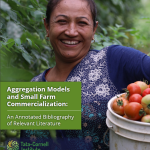Research Area: Markets & Value Chains

Wasted Potential: Tackling Food Loss and Waste Across Transforming Food Systems
As the world seeks to achieve zero hunger and mitigate the environmental degradation tied to food production and consumption, reducing food loss and waste is a critical challenge for policymakers in developed and developing countries alike. Wasted Potential: Tackling Food Loss and Waste Across Transforming...

Making Supermarkets Profitable for India’s Small Farms
This policy brief presents the results of a study examining the impact of supermarkets on smallholder farmers in India. Using field survey data collected from 795 farm households across four states representing India’s varied agroclimatic and socioeconomic regions, researchers found that farmers who sold to...

Determinants and Income Effects of Small Farmers Selling to Supermarkets versus Traditional Market Channels in Four Regions of India
Abstract Read a policy brief based on this study. Using endogenous switching regressions to calculate transitional heterogeneity which we have used to build counterfactual scenarios to identify the treatment effects for both sellers to supermarkets and sellers to traditional markets, the results support neither a...

Identifying the Number of FPOs Promoted in India
This special policy brief provides an estimate of the number of active farmer producer organizations (FPOs) promoted in India from 2003 to 2024 and makes the case for a centralized system for tracking FPOs. A system to identify and track FPO promotion and performance in...

Essays in Agriculture Economics, Climate Change, and Nutrition
Abstract The dissertation consists of three essays in the field of agriculture economics, climate change, and nutrition. I have structured it as three chapters, namely ‘Fertilization Impact Of Atmospheric Carbon Dioxide On Agricultural Yield’, ‘Are Production And Consumption Decisions Independent? Identifying Separability In Indian Agriculture’,...

Reducing the True Cost of Food-Based Safety Nets: Evidence from India’s Subsidized Food Program
Abstract Public procurement of food plays a pivotal role in determining the production and consumption of various food items. This is particularly true for staple grains in countries such as India, where the government procures over 40 percent of rice and wheat. This grain is...

Did the COVID-19 Lockdown Reverse the Nutritional Gains in Children? Evidence from Rural India
Abstract Read a policy brief based on this study. To address the missing link that goes beyond the changes in dietary consumption and food expenditures to assess the impact of the pandemic on child undernutrition, specifically anthropometric outcomes, this paper uses primary panel data (pre-...

Promoting Millets in the Public Distribution System
This special policy brief provides cost-saving estimates associated with the potential introduction of millets into India’s Public Distribution System (PDS), which provides subsidized food to more than 800 million people. This analysis provides policymakers and other stakeholders with valuable information that can be used to...

Can We Agree on a Food Loss and Waste Definition? An Assessment of Definitional Elements for a Globally Applicable Framework
Abstract Recent strategies for achieving sustainable food systems have called for reducing food loss and waste (FLW), most notably Sustainable Development Goal (SDG) target 12.3. This review aims to compare FLW definitions that are relevant to SDG target 12.3 and opportunities to harmonize the FLW definition. Using the FAO...

Aggregation Models and Small Farm Commercialization: An Annotated Bibliography of Relevant Literature
Smallholder aggregation models around the globe have the potential to contribute significantly to agricultural growth and productivity by facilitating improved access to credit, inputs, markets, and information. Aggregation models, including farmer producer organizations (FPOs) and cooperatives, are institutional arrangements by which small and marginal farmers,...

